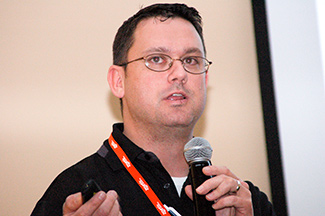Customize Your Index
Working group seeks to enhance decision support using customizable indexes across breeds.
by Troy Smith, field editor
BROOKINGS, S.D. (June 19, 2019) — University of Nebraska geneticist Matt Spangler believes beef cattle producers need better tools for making genetic selection decisions. In the Advancements in Genomics and Genetic Prediction Committee meeting, part of the 2019 Beef Improvement Federation symposium in Brookings, S.D., Spangler said work is underway to develop an online tool for selecting seedstock suited to an individual ranch and its unique production system.

Matt Spangler in Genomics and Genetic Prediction Committee
University of Nebraska geneticist Matt Spangler described a collaboration among land-grant universities, private industry and USDA to develop computer software that would enable individual producers to create customized selection indexes. [Photo by Troy Smith]
“Trait EPDs (expected progeny difference values) have been available for about four decades now. Some breed associations generate over 20 EPDs per animal, and the number is growing,” stated Spangler. “The question is how to best use them for selection decisions. It’s unreasonable to think all of those numbers can be optimally used.”
Since selection to improve multiple traits simultaneously can be cumbersome, selection indexes were developed to make decisions easier. According to Spangler, an index represents a collection of trait EPDs weighted by their economic value such that traits with greater impacts to production goals carry more weight. Different indexes include different combinations of traits, and associate different economic values with them. Consequently, a producer must understand what traits to emphasize in his or her herd and what indexes to use to further production and marketing goals.
“Selection indices were designed to help improve the commercial producer’s net profit,” said Spangler, admitting indexes do have their shortcomings. “They are not comparable across breeds. and they assume constant environmental and marketing conditions. And they are not well-understood by producers.”
Spangler described a collaboration among land-grant universities, private industry and USDA to develop computer software that would enable individual producers to create customized selection indexes. These customized selection tools would be based on each producer’s unique herd-level economics and production levels and would be applicable across breeds.
“We hope to have a working model ready by the first quarter of 2020,” reported Spangler.
The 2019 BIF Annual Convention was hosted by South Dakota State University and the South Dakota Beef Breeds Council June 18-21 at the University Comfort Suites and Convention Center in Bookings. ANGUS MEDIA® provides comprehensive online coverage of the event at www.BIFconference.com. Visit the Newsroom for summaries, proceedings, PowerPoints, video and/or audio of the sessions and the Awards page for announcements and photos of award winners.
Editor’s Note: This summary was written under contract or by staff of ANGUS MEDIA®. Through an agreement with the Beef Improvement Federation,
we encourage reprinting of the articles to those who will adhere to the
reprint guidelines available on this site. Please review those
guidelines or contact Shauna Rose Hermel,
editor, at 816-383-5270. PowerPoints are posted with permission of the
presenter and may not be reproduced in whole or in part without the
express permission of the presenter. We welcome educational venues and
cattlemen to link to this site as a service to their audience.
For questions about this site, or to notify us of broken links, click here. Look for additional coverage in the Angus Journal, the Angus Beef Bulletin, the Angus Journal Daily, the Angus Beef Bulletin EXTRA and Angus TV.


